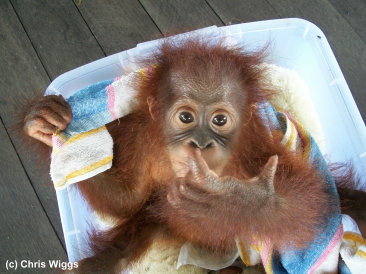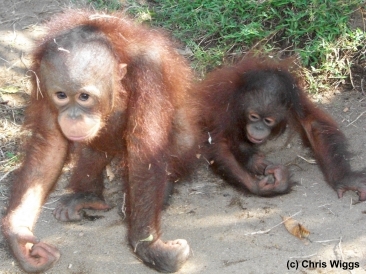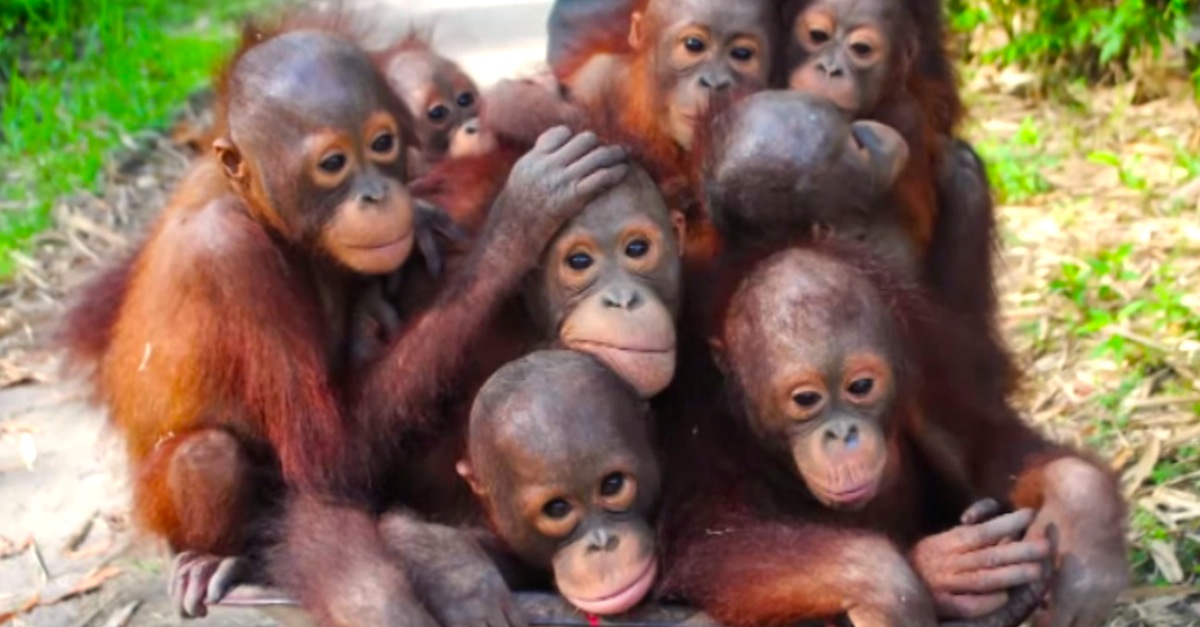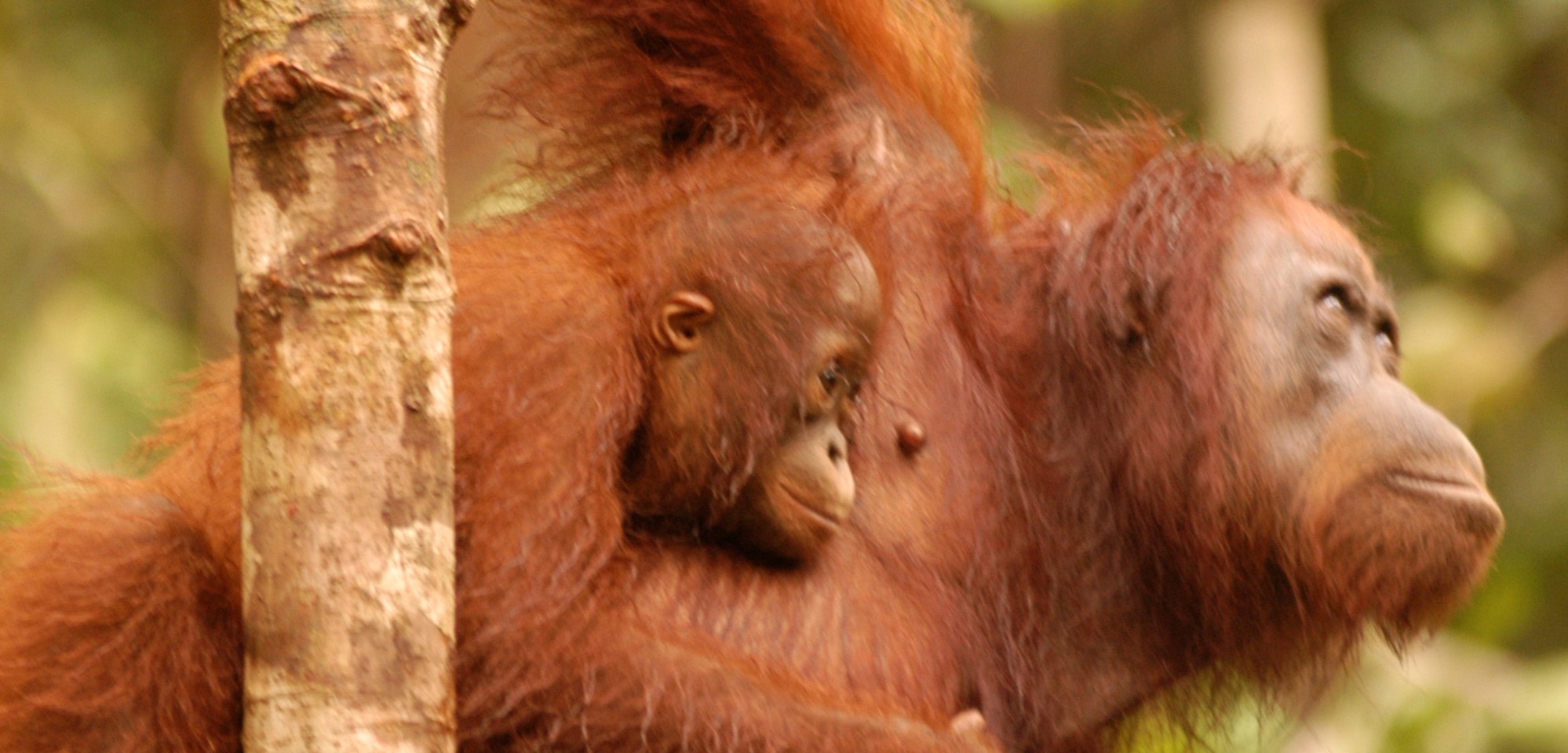Orangutan Mom and Baby Reintroduced After C Section
Due to the illegal wildlife trade and the rate of deforestation in Indonesia and Malaysia over the last 40 years, at that place'southward been an alarming increase in captive orangutans - in zoos, wildlife parks, wild animals markets, and private homes, both domestically and internationally. Equally a result, conservation organizations are increasing efforts to rescue, rehabilitate, and release these orangutans. Ex-captive, wild-built-in orphans now represent a significant proportion of the surviving orangutan population.
Orangutan rehabilitation is complex and fraught with difficulties. It's currently one of the virtually controversial and hotly-debated aspects of orangutan conservation.
The start orangutan rehabilitation project began in the Malaysian state of Sarawak in the 1960s and was followed soon afterward by like projects in Sabah in Malaysia, and Sumatra and Kalimantan in Republic of indonesia. The projection at Tanjung Puting National Park in Central Borneo is arguably the most famous. At the fourth dimension, lilliputian was known about the status of wild orangutans, the size of the remaining populations, and fifty-fifty their life histories and ranges. Because wild studies were in their infancy, rehabilitation methods were largely experimental.

Our partner the Sumatran Orangutan Conservation Program (SOCP) has run the world'southward only Sumatran orangutan rehabilitation and release project since 2001. To engagement, it has cared for well-nigh 400 orangutans, releasing more 180 of them back into the wild.
Although different project founders had their own motivations for establishing each program, they were usually initially fix up to help enforce orangutan protection laws by providing legal belongings facilities for confiscated orangutans, and, from an animate being welfare perspective, giving orangutans confiscated from often appalling weather a risk to one time once again alive independently in the forest (Frey, 1978). Due to doubtfulness over the number of orangutans living in the wild, rehabilitation programs in the 1970s placed an emphasis on releasing orangutans into areas with existing wild orangutans, to supplement populations that were considered likewise small to be viable (Russon, 2009). For example, at Tanjung Puting, betwixt 1971 and 1994, at least 180 orangutans were released and at Bohorok in Gunung Leuser National Park in Sumatra, 218 orangutans were released between 1973 and 2000 (Yeager, 1997).
Most orangutans in rehabilitation centers were confiscated past forestry department officials. Occasionally they're handed in by people unable to look after them. The time spent in captivity and the age upon arrival vary, only most are confiscated when they are young, with between 63-97% of intakes under seven years old (Russon, 2009).
The living conditions in captivity also vary, just inadequate care under poor conditions is the most prevalent, and physical harm often includes gunshot and machete wounds, broken or missing limbs, scars and wounds from chaining, paralysis, incomprehension, and internal damage. Confiscated orangutans have as well usually suffered extreme behavioral and psychological damage, including prolonged periods of isolation, physical and sexual abuse and aberrant associations with humans (Ibid).
The behavioral abnormalities observed in ex-captive orangutans has been ane of the almost challenging aspects of the rehabilitation process, and has led to a divergence in the methods used, with some practitioners advocating limiting human being contact severely, to endeavor and remove learned human behaviors and encourage those seen in wild orangutans, while others believe orangutans, especially infants and juveniles, should be assigned a homo caregiver to teach them such behaviors, on account of the long period of dependence betwixt a mother and infant in the wild. Regardless of the method used, almost all rehabilitation centers and release sites see abnormalities in released individuals. At Tanjung Puting, released orangutans occasionally attacked humans, others ofttimes reappeared at the release military camp with deep wounds, indicating negative encounters with their wild counterparts, and others have been seen either ill or underweight (Yeager, 1997). Similar observations take been made at Bohorok in Gunung Leuser National Park (Dellatore et al., 2009). High infant bloodshed has besides been observed in a number of release sites, indicating released ex-captive females lack the mothering skills of wild females (Russon, 2009).

The prevalence of diseases in ex-captive orangutans and the risk of these diseases spreading to wild populations is also a major concern. Ex-captive orangutans ofttimes behave human diseases such equally hepatitis-a/b/c, tuberculosis, tetanus, respiratory disease, poliomyelitis and significant parasite loads, and while diseases are ordinarily identified during a screening and quarantine period, there's a danger of these potentially fatal diseases beingness spread to wild populations if undetected (Russon, 2009). This threat has been exacerbated in contempo years by the flourishing tourist merchandise that has developed around the ex-captive orangutans. Tourism and the acquirement it raises is an incredibly of import conservation tool, providing jobs and income for local people and governments and a financial incentive for conserving wild animals. The large amounts of coin tourists are willing to pay to see mountain gorillas in Central Arica is one of the main reasons for their continued conservation, and there'south also a need to see orangutans in the wild (Redmond, 2008). However, unlike gorillas, which alive terrestrially in large family unit groups, wild orangutans live solitary lives high up in the dense forest awning and are hard to observe from the forest floor.
 Ex-captive orangutans, all the same, tend to spend extended periods on the basis, are more gregarious than their wild counterparts, and, due to their captive backgrounds, are usually comfortable around humans. Sepilok in the Malaysian state of Sabah, Bohorok, and Tanjung Puting all allow tourists to visit the ex-captive orangutan release sites, and, at the latter two sites, humans have been observed soliciting contact with the orangutans. Studies have shown that primate populations in shut proximity to humans have higher levels of parasitic infection than those that rarely come in to contact, and our genetic closeness to orangutans makes them highly susceptible to human diseases (Wallis & Lee, 1999). It is feared that if an ex-convict orangutans were to grab a disease from a human tourist, it could decimate the wild populations, who do not have any natural immunity to human diseases. Although the semi-lonely nature of wild orangutans would commonly restrict disease transmission, released ex-captives are more gregarious and, defective the social skills they would learn from their mother, have been seen observed at Tanjung Puting soliciting play with wild females and their offspring, and climbing in and out of wild female person'due south solar day nests, while respiratory and skin diseases have been seen to be transmitted between individuals (Galdikas, 1999; Yeager, 1997).
Ex-captive orangutans, all the same, tend to spend extended periods on the basis, are more gregarious than their wild counterparts, and, due to their captive backgrounds, are usually comfortable around humans. Sepilok in the Malaysian state of Sabah, Bohorok, and Tanjung Puting all allow tourists to visit the ex-captive orangutan release sites, and, at the latter two sites, humans have been observed soliciting contact with the orangutans. Studies have shown that primate populations in shut proximity to humans have higher levels of parasitic infection than those that rarely come in to contact, and our genetic closeness to orangutans makes them highly susceptible to human diseases (Wallis & Lee, 1999). It is feared that if an ex-convict orangutans were to grab a disease from a human tourist, it could decimate the wild populations, who do not have any natural immunity to human diseases. Although the semi-lonely nature of wild orangutans would commonly restrict disease transmission, released ex-captives are more gregarious and, defective the social skills they would learn from their mother, have been seen observed at Tanjung Puting soliciting play with wild females and their offspring, and climbing in and out of wild female person'due south solar day nests, while respiratory and skin diseases have been seen to be transmitted between individuals (Galdikas, 1999; Yeager, 1997).
 To mitigate these problems, and in recognition of the fact that, due to an dispatch in deforestation, ex-captives were probable stressing wild populations and competing with them for food, the Indonesian authorities passed a law in 1995 restricting the release of ex-convict orangutans into areas with a feasible wild orangutan population, and aimed to restrict tourist activity at release sites. Today, although tourists can withal visit the previously released ex-captives at Bohorok and Tanjung Puting, all confiscated orangutans are now quarantined and rehabilitated at specialist clinics, and released into areas devoid of wild orangutans, or areas without a feasible wild population, and closed to tourists, although such sites in both Indonesia and Malaysia are becoming almost impossible to locate. Most release projects also provide 'soft releases' for orangutans, where provisions and other supports are offered for a short catamenia later the initial release, and in some cases, indefinite supplementary feeding is provided. Post-release monitoring of ex-captives has historically been difficult, due to a combination of lack of funds, the tough terrain and the orangutans wide-ranging patterns, but is hoped that new developments in microchipping applied science could aid with mail service-release monitoring, and preventative measures could exist taken to improve post-release mortality and success rates (Russon, 2009).
To mitigate these problems, and in recognition of the fact that, due to an dispatch in deforestation, ex-captives were probable stressing wild populations and competing with them for food, the Indonesian authorities passed a law in 1995 restricting the release of ex-convict orangutans into areas with a feasible wild orangutan population, and aimed to restrict tourist activity at release sites. Today, although tourists can withal visit the previously released ex-captives at Bohorok and Tanjung Puting, all confiscated orangutans are now quarantined and rehabilitated at specialist clinics, and released into areas devoid of wild orangutans, or areas without a feasible wild population, and closed to tourists, although such sites in both Indonesia and Malaysia are becoming almost impossible to locate. Most release projects also provide 'soft releases' for orangutans, where provisions and other supports are offered for a short catamenia later the initial release, and in some cases, indefinite supplementary feeding is provided. Post-release monitoring of ex-captives has historically been difficult, due to a combination of lack of funds, the tough terrain and the orangutans wide-ranging patterns, but is hoped that new developments in microchipping applied science could aid with mail service-release monitoring, and preventative measures could exist taken to improve post-release mortality and success rates (Russon, 2009).
Despite these difficulties and ongoing issues, orangutan rehabilitation has besides brought huge benefits and remains an important office of orangutan conservation and animal welfare. Continued deforestation and the illegal wild animals trade accept caused orangutans being kept in appalling weather condition throughout Indonesia and Malaysia, and often in other parts of the world. The existence of rehabilitation centers and the knowledge they volition take rescued individuals has provided impetus to forestry department officials to confiscate illegally endemic orangutans, and these centers, all given the support of international NGO's, are an essential facet of constabulary enforcement (Ibid). If rescue centers were not able to treat these ex-captives, they would probable dice in captivity, in often appalling conditions; and while studies accept shown that ex-captives accept college than boilerplate mortality and babe bloodshed rates (Russon, 2009; Yeager, 1997), it's likewise likely that a big number of those released into forests have survived and are living gratuitous, wild lives (Galdikas, 1999). Those orangutans not suitable for release are at present oftentimes housed in sanctuary like enclosures in centers, where they savour a vastly improved quality of life, and at the Sumatran orangutan release site in the Bukit Tigapuluh landscape, a sanctuary for orangutans deemed unsuitable for rehabilitation has been developed in a semi-natural setting (Perth Zoo, 2009).
Rescue and rehabilitation projects are likewise important for the role they play in the relocation of wild orangutans from recently deforested areas to still forested areas, a procedure oft referred to every bit translocation (Becket. al., 2007). Every bit the woods is cut down and orangutans are displaced, those that have been living independently in the woods, unremarkably adults contained of their mothers, and have been captive for a just short menstruation of time, often just a number of hours or days, tin be relocated and released immediately into other areas of forest, without going through the rehabilitation process, limiting their exposure to human behaviors. Existing rescue and rehabilitation centers oft provide the necessary logistical support and infrastructure to help this work.

While the tourism industry brings with it complications, and the threat of humans infecting ex-captives and wild orangutans with human diseases remains an ever-present threat, it has likewise brought with information technology economic benefits, employment for local people and has helped create local, institutional and governmental support and commitment for orangutan conservation (Galdikas, 1999). These easily accessible ex-captive orangutans take also made viewing orangutans in the wild possible for large numbers of people, and remain charismatic representatives of their under-siege species.

In that location is too bear witness that the presence ex-convict orangutan release sites have, in some cases, strengthened the example for conserving the rainforest. The fall of President Soeharto from power in May 1998 after 32 years of dictatorial dominion plunged Indonesia into political chaos, and vast areas of forest throughout the land were logged with dispensation. Tanjung Puting National Park was overrun with illegal loggers (EIA, 1999), but the surface area in the vicinity of the almost high profile release site in the park, known as Camp Leakey, an area with extensive local support and a high international profile, was left largely undisturbed (OFI, 1999). Two onetime logging concessions in Fundamental Kalimantan that were to be turned into a palm oil plantation are at present known as the Lamandau River Wildlife reserve, which acts equally a government-designated orangutan release site, later on lobbying past NGO's in the area, and surveys are currently underway to locate suitable release sites in Due west Kalimantan. Worldwide media attention has recently been given to plans by a lurid and paper visitor to convert a portion of the Bukit Tigapuluh landscape in Sumatra into a plantation, with item attention being paid to areas that act as a Sumatran orangutan release site, and the release of a zoo-born adult female from Perth Zoo into this area in 2006 has ensured support for its continued protection from the West Australian government (Russon, 2009).
In 2007, the Indonesia regime formulated an action program for orangutan conservation, and i of its objectives was the release of all ex-convict orangutans and the closure of all current orangutan rehabilitation centers in the country by 2015 (MoF, 2009). Continued forest conversion, the illegal pet trade, the significant number of ex-captives currently in overcrowded rehabilitation centers and the difficulty in finding and securing suitable release sites means this is perhaps an optimistic timeframe, but securing an independent future for these wild-born, ex-convict orangutans yet remains a hugely important part of the wider conservation motion.
References
Brook, B.B., Walkup, K., Rodrigues, Yard., Unwin, S., Travis, D. & Stoinski, T. (2007). All-time practise guidelines for the reintroduction of Neat apes.SSC Primate Specialist Grouping of the World Conservation Union, Gland, Switzerland.
Dellatore, D.F., Waitt, C.D. & Foitova, I. (2009). Two cases of mother-infant cannibalism in orangutans.Primates.
Frey R. (1978). Management of Orangutans. BIOTROP Special Publication.
Galdikas B. (1999). Orangutan Odyssey. Harry North. Abrams, U.s..
OFI. (1999). A message from Dr Galdikas. Orangutan Foundation International, Cherry Ape newsletter.
Perth Zoo. (2009). Perth Zoo's piece of work in Bukit Tigapuluh. website.
Redmond I. (2008). The Primate Family Tree. Firefly Books Ltd., UK.
Russon, A.Eastward. (2009). Orangutan rehabilitation and reintroduction. In Wich, South.A., Utami Atmoko, S.Due south., Mitra Setia, T. & Van Schaik, C.P. editors. Orangutans: Geographic Variation in Behavioral Ecology and Conservation. Oxford University Printing.
Yeager, C.P. (1997). Orangutan rehabilitation in Tanjung Puting National Park, Republic of indonesia. Conservation Biological science, Vol. 11, No. 3, pp. 802-805.
Orang Utan Republik Foundation (OURF) is non a political system and does not endorse or sponsor activities that attack or condemn individuals, organizations or governments.
![]()
Source: https://www.orangutanrepublik.org/learn/solutions/rehabilitation-and-reintroduction/
Post a Comment for "Orangutan Mom and Baby Reintroduced After C Section"